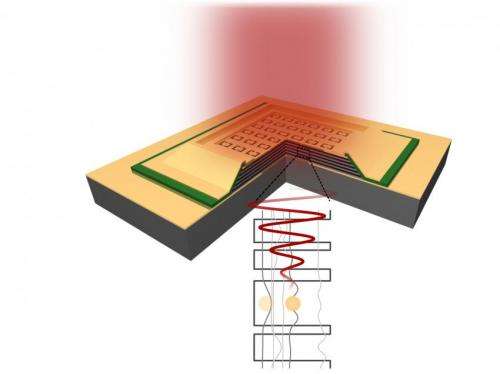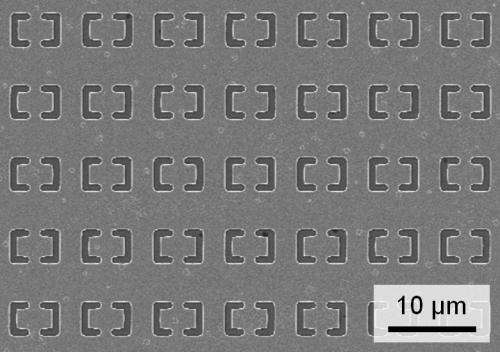Ultra-thin light detectors

A new, extremely thin kind of light detectors was created at Vienna University of Technology. Two very different technologies were combined for the first time: metamaterials and quantum cascade structures.
Subtle interactions of electrons and light make them so valuable for technology: ultra-thin systems of semiconductor layers can turn electrical voltage into light. But they can also be used the other way around and serve as light detectors. Until now, it has been hard to couple light into these layered semiconductor systems. Scientists at Vienna University of Technology solved this problem. They used metamaterials, which are able to manipulate light in the terahertz range due to their special microscopic structure.
Customized Semiconductor Layers
"Ultra-thin layered semiconductor systems have the great advantage, that their electronic properties can be very precisely tuned", says Professor Karl Unterrainer (TU Vienna). By selecting suitable materials, by tuning the thickness of the layers and the geometry of the device, the behaviour of the electrons in the system can be influenced. That way, quantum cascade lasers can be built, in which the electrons jump from layer to layer and emit a photon with each jump. Also, light detectors can be created, with a selective sensitivity to one particular wavelength.

The problem, however, is that quantum physics prohibits photons with a certain directions of oscillation (polarization) from interacting with the electrons of the semiconductor system. Light which hits the layered surface head-on, cannot influence the electron in the semiconductor. Therefore a method is required to rotate the polarization of the incident light, so that it can be detected in the semicionductor layers.
An Artificial Butterfly
This can be done with an unusual method – with metamaterials. A metamaterial has an ordered geometric structure with a periodicity smaller than the wavelength of the incident light. The light is scattered according to the structure's geometry, some wavelengths may be absorbed, others reflected. The intriguing play of colours on a butterfly's wings comes from exactly this kind of effects. Metamaterials on top of a semiconductor structure are able to rotate the polarization of the incoming light so that it can interact with the electrons inside.
The light used in the experiment has a considerably longer wavelength than visible light: It is radiation in the terahertz- or infrared regime, with a wavelength of about a tenth of a millimetre. This kind of radiation has important technological applications, for instance for next-generation computer technology, but it is difficult to work with these kind of waves.
A Detector on a Chip
The discovery made at Vienna University of Technology now opens up the possibility of integrating a light detector for terahertz radiation into a chip. "With conventional fabrication methods, large arrays of such detectors can be built", Unterrainer explains. They do not take up much space: Layers with a thickness in the order of magnitude of nanometers are enough to detect light – the detector is more than a thousand times thinner than the wavelength of the light which is being detected.
More information: www.nature.com/srep/2014/14031 … /full/srep04269.html
Provided by Vienna University of Technology





















